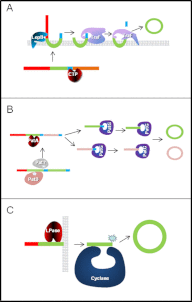Discovering the bacterial circular proteins: bacteriocins, cyanobactins, and pilins
- PMID: 22700986
- PMCID: PMC3411037
- DOI: 10.1074/jbc.R112.354688
Discovering the bacterial circular proteins: bacteriocins, cyanobactins, and pilins
Abstract
Over recent years, several examples of natural ribosomally synthesized circular proteins and peptides from diverse organisms have been described. They are a group of proteins for which the precursors must be post-translationally modified to join the N and C termini with a peptide bond. This feature appears to confer a range of potential advantages because these proteins show increased resistance to proteases and higher thermodynamic stability, both of which improve their biological activity. They are produced by prokaryotic and eukaryotic organisms and show diverse biological activities, related mostly to a self-defense or competition mechanism of the producer organisms, with the only exception being the circular pilins. This minireview highlights ribosomally synthesized circular proteins produced by members of the domain Bacteria: circular bacteriocins, cyanobactins, and circular pilins. We pay special attention to the genetic organization of the biosynthetic machinery of these molecules, the role of circularization, and the differences in the possible circularization mechanisms.
Figures



Similar articles
-
New type non-lantibiotic bacteriocins: circular and leaderless bacteriocins.Benef Microbes. 2012 Mar 1;3(1):3-12. doi: 10.3920/BM2011.0047. Benef Microbes. 2012. PMID: 22348904 Review.
-
A prevalent peptide-binding domain guides ribosomal natural product biosynthesis.Nat Chem Biol. 2015 Aug;11(8):564-70. doi: 10.1038/nchembio.1856. Epub 2015 Jul 13. Nat Chem Biol. 2015. PMID: 26167873 Free PMC article.
-
Structure and mechanism of lanthipeptide biosynthetic enzymes.Curr Opin Struct Biol. 2014 Dec;29:58-66. doi: 10.1016/j.sbi.2014.09.006. Epub 2014 Oct 14. Curr Opin Struct Biol. 2014. PMID: 25460269 Free PMC article. Review.
-
Solution structures of the linear leaderless bacteriocins enterocin 7A and 7B resemble carnocyclin A, a circular antimicrobial peptide.Biochemistry. 2013 Jun 11;52(23):3987-94. doi: 10.1021/bi400359z. Epub 2013 May 31. Biochemistry. 2013. PMID: 23725536
-
Plantaricyclin A, a Novel Circular Bacteriocin Produced by Lactobacillus plantarum NI326: Purification, Characterization, and Heterologous Production.Appl Environ Microbiol. 2017 Dec 15;84(1):e01801-17. doi: 10.1128/AEM.01801-17. Print 2018 Jan 1. Appl Environ Microbiol. 2017. PMID: 29030449 Free PMC article.
Cited by
-
Network analysis of circular permutations in multidomain proteins reveals functional linkages for uncharacterized proteins.Cancer Inform. 2015 Feb 19;13(Suppl 5):109-24. doi: 10.4137/CIN.S14059. eCollection 2014. Cancer Inform. 2015. PMID: 25741177 Free PMC article.
-
Identification and classification of known and putative antimicrobial compounds produced by a wide variety of Bacillales species.BMC Genomics. 2016 Nov 7;17(1):882. doi: 10.1186/s12864-016-3224-y. BMC Genomics. 2016. PMID: 27821051 Free PMC article.
-
Bacteriocins of lactic acid bacteria: extending the family.Appl Microbiol Biotechnol. 2016 Apr;100(7):2939-51. doi: 10.1007/s00253-016-7343-9. Epub 2016 Feb 10. Appl Microbiol Biotechnol. 2016. PMID: 26860942 Free PMC article. Review.
-
Novel protein science enabled by total chemical synthesis.Protein Sci. 2019 Feb;28(2):313-328. doi: 10.1002/pro.3533. Epub 2018 Dec 18. Protein Sci. 2019. PMID: 30345579 Free PMC article. Review.
-
Amylocyclicin, a novel circular bacteriocin produced by Bacillus amyloliquefaciens FZB42.J Bacteriol. 2014 May;196(10):1842-52. doi: 10.1128/JB.01474-14. Epub 2014 Mar 7. J Bacteriol. 2014. PMID: 24610713 Free PMC article.
References
-
- Maqueda M., Sánchez-Hidalgo M., Fernández M., Montalbán-López M., Valdivia E., Martínez-Bueno M. (2008) Genetic features of circular bacteriocins produced by Gram-positive bacteria. FEMS Microbiol. Rev. 32, 2–22 - PubMed
-
- Martin-Visscher L. A., van Belkum M. J., Vederas J. C. (2011) in Prokaryotic Antimicrobial Peptides: From Genes to Application (Drider D., Rebuffat S., eds) pp. 213–236, Springer, Heidelberg
-
- Conlan B. F., Gillon A. D., Craik D. J., Anderson M. A. (2010) Circular proteins and mechanisms of cyclization. Biopolymers 94, 573–583 - PubMed
-
- van Belkum M. J., Martin-Visscher L. A., Vederas J. C. (2011) Structure and genetics of circular bacteriocins. Trends Microbiol. 19, 411–418 - PubMed
-
- Kawai Y., Kemperman R., Kok J., Saito T. (2004) The circular bacteriocins gassericin A and circularin A. Curr. Protein Pept. Sci. 5, 393–398 - PubMed
Publication types
MeSH terms
Substances
LinkOut - more resources
Full Text Sources

